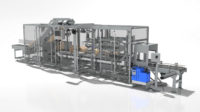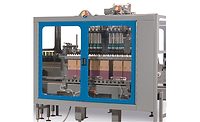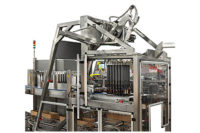For beverage containers on the shelf, standing out tends to be the name of the game. To create a differentiated shelf presence, beverage packages often flaunt different shapes, materials and styles. End-of-aisle, retail-ready displays of different shapes and sizes can add to the shelf appeal.
“[Retailers] all want something different on their shelf,” says Mike Wilcox, vice president of sales, marketing and after-market sales at Delkor Systems Inc., St. Paul, Minn. Some want a package that can go directly on the shelf, others want to minimize material, and still others want a different look or packaging size or case size, he says. “It puts a lot of challenge on the beverage producers and consequently the machine builders to accommodate this demand.”
This includes the case packing industry, which has had to evolve and innovate to keep up with industry trends and demands for different types of packages and displays.
For example, one Delkor client needed a machine that would pack bottles into display trays and attach plastic handles to two- and four-packs of bottles for the client’s retail customer. To accommodate this, Delkor designed a Multiple-Pak H Series case packer, which features an integrated handle applicator.
“It first forms the display shipper or the display case, and it then transfers that to a loading position, and the appropriate number of bottles are picked up and loaded into either one or two cases simultaneously,” explains Dale Andersen, Delkor’s president and chief executive officer. “After the bottles have been placed into this display shipper or display case, they then move to the next section where this plastic carrier applicator will pick an entire pack pattern of plastic carriers. So, let’s say you have 12 bottles, and you’re going to put a two-pack carrier on them; it’ll actually pick six carriers at a time and put them on simultaneously.”
To save packaging material, some beverage-makers have opted to lightweight their containers and requested that their shipping cases not use partitions in order to reduce waste after shipping. This presents a challenge to the case packing industry to ensure these containers are not damaged during the packing and shipping processes, notes Mario Mazzotta, customer service and marketing manager for Standard-Knapp Inc., Portland, Conn. For these scenarios, Standard-Knapp offers its new 939S Versatron case packer with a Pic-N-Place Module.
“This case packer is ideal for partitionless case packing and places the entire case of product directly into the incoming cases with virtually no drop,” Mazzotta says. “With the need for tighter cases when packing partitionless, using the Pic-N-Place module ensures that all of the product gets into the case and packs with virtually no breakage.” The Versatron can be engineered to handle single or tandem cases and can run at speeds of 30 cycles a minute, he adds.
Westfalia Technologies Inc.’s Deam Division, which is based in York, Pa., also has perfected its method of handling lightweight containers through a soft, drop-load technique. These case loaders form the pack pattern and then drop the product approximately the same distance as its height into the case. At the same time, the machine guides the case with an air cylinder to cushion the fall and catch the product, explains Fred Beer, president of the Deam Division.
“When you drop the product, you actually compress the cylinder, you compress the air, so it acts like a cushion, and then on the controls of the machine, if you retract the case lifter and you time the motion properly, you’re getting a double effect,” he says. “You’re almost following the product as it hits the bottom of the case, and you’re getting the shock absorption of the air cylinder, which allows you to run pretty efficiently.” Beer compares this packing mechanism to catching a baseball. If you hold your gloved hand rigid when trying to catch the ball, it’ll bounce right out of your glove, he says. “But if you catch it, you’re basically pulling your hand back as you catch the ball, except your hand is moving back a little slower than the ball, and it just cushions it in your glove.”
Aside from different container weights, the various container shapes can influence case packers as well. “We like to say every product has a ‘personality’ like people,” says Terry Zarnowski, director of sales and marketing at Schneider Packaging Equipment Co. Inc., Brewerton, N.Y. “Personalities such as odd shapes can be nested to minimize the amount of air in a package — for example, pouches may have a wider bottom than the top, so we would rotate each product
180 degrees to nest them one on top of the other.”
Schneider’s newest case packers, the Robotic Carton and Case Loaders (RCCLs), are designed to handle drink pouches and single-serve aseptic package formats at high speeds, Zarnowski says. “The RCCL can orient each product in either a top-load carton or case and nest them in order to improve sustainability through a reduction in packaging requirements,” he adds.
The versatility value
In this age of SKU proliferation and expanding container options, case packer customers are increasingly looking for flexibility to boost productivity, experts say.
“Many lines run a limited number of SKUs and pack configurations, but nobody wants to buy a machine that only meets today’s requirements,” says Steve Lipps, director of marketing at Douglas Machine Inc., Alexandria, Minn.
Schneider’s Zarnowski says many of its customers are asking for auto-change packages, such as its ProAdjust package, to reduce changeover time between different production runs. This module, which can be retrofitted to almost any machine, allows operators to set up different packing instructions once on the human-machine interface, and then the system automatically adjusts as needed during production runs, according to the company’s website. These fast changeover times enhance the overall equipment effectiveness of the packing line, Zarnowski adds.
Similarly, Tarpon Springs, Fla.-based A-B-C Packaging Machine Corp.’s new Model 206 packer uses servo operation to accommodate product variations, the company says. The machine does not require any tool changeparts but instead makes powered adjustments, which maintain all machine parameters within centerline points, ensuring fast, repeatable changeovers, it says.
However, speed and automatic adjustments can only take the packing line’s productivity so far. Errors and system jams can reduce overall line efficiency, so intelligent machines that can automatically correct these issues are needed to keep the system running smoothly, experts say. Delkor’s Model 650 case packer, which debuted at Pack Expo 2012, can identify defects such as incomplete cases and defective cases and pack patterns at multiple points in the system and discharge the defect without needing to stop the line, according to the company’s website. The discharged product is then moved to a holding area where it can be reworked and put back into the stream, Wilcox says. The less the line needs to be interrupted, the greater the return on investment, he adds.
Another way to boost line efficiency is to make sure the case packer is operating in sync with the rest of the production line. “Because a case packer is in that packaging line, you need to make sure that your case packing system can out-run the filler that’s making the primary packaging, so you don’t impact the overall line efficiencies in a negative way,” Westfalia’s Beer explains.
Overall, members of the case packing industry are looking for solutions that can keep up with the speeds and accommodate all of the new packaging types and pack patterns that continue to pop up as the packaging industry pushes forward with innovation, experts say.
“Our marketing people are always coming up with new package types and new package sizes, and every time they do, it impacts the downstream case packing line,” Westfalia’s Beer says. “But I think it’s a challenge that every manufacturer approaches in a positive sense of, ‘Look, you know our customers require efficient and effective packaging of their products, and that’s what we’re destined to do.’”
That’s a wrap
The case wrapping industry also faces demands for enhancing product appearance on the shelf and improving sustainability.
“Film-wrapped packs are often the retail display package that the customer sees on the shelf and uses,” Douglas Machine’s Lipps explains. “Shrink tunnel technology that produces the best appearance and consistency is critical.”
Many shrink tunnels create heat and move around at high speeds to try to avoid hot spots, but this can affect the film as it is shrinking and create a distorted pack or excessive wrinkles in the shrink film, Lipps explains. Douglas Machine’s Contour series of case wrappers with shrink tunnel technology instead heats air from the bottom and uses patented lower-velocity laminar air flow to create better-looking and more-durable packages, he says. The machines also use a polyethylene film that can be printed with branding for an enhanced appearance and used for retail display, offering customers a cost-effective, lightweight packaging option, he adds.
Like case packers, shrink wrappers also face expectations of improving sustainability. Some manufacturers are turning to nested package wrapping methods to reduce package costs and material waste by eliminating corrugate trays and pads, Douglas Machine’s Lipps says. Using its patented pinless SlipStream metering systems and product group containment systems, Douglas Machine’s Contour SPS-80 shrink-wrap system and Contour M-Series multi-wrap machines can run 80 cycles a minute and 30 to 100 cycles a minute, respectively, to produce film-only wraps or film wraps with support pads, he says.
As packaging demands change, the case packer and wrapper industry continues to adapt to handle and ship new packaging sizes and styles, to safely transport the product to the store shelves, and to help them make the best possible impression on shoppers.






